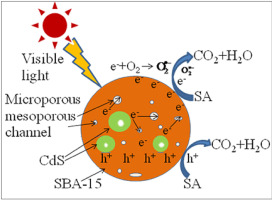当前位置:
X-MOL 学术
›
Ecotox. Environ. Saf.
›
论文详情
Our official English website, www.x-mol.net, welcomes your
feedback! (Note: you will need to create a separate account there.)
Fabrication of CdS-SBA-15 nanomaterials and their photocatalytic activity for degradation of salicylic acid under visible light.
Ecotoxicology and Environmental Safety ( IF 6.2 ) Pub Date : 2020-01-02 , DOI: 10.1016/j.ecoenv.2019.110139 Junhong Wang 1 , Xianzhao Shao 1 , Junhai Liu 1 , Xiaohui Ji 1 , Jianqi Ma 1 , Guanghui Tian 1
Ecotoxicology and Environmental Safety ( IF 6.2 ) Pub Date : 2020-01-02 , DOI: 10.1016/j.ecoenv.2019.110139 Junhong Wang 1 , Xianzhao Shao 1 , Junhai Liu 1 , Xiaohui Ji 1 , Jianqi Ma 1 , Guanghui Tian 1
Affiliation

|
CdS-SBA-15 nanomaterials were synthesized by solvothermal method using cadmium nitrate as cadmium source and thiourea as sulfur source. The properties of as-prepared materials were characterized by means of XRD, FTIR, TEM, XPS, N2 physisorption, UV-Vis DRS and PL spectra, etc. The results show as-synthesized materials have partially ordered mesoporous structure, larger specific surface area, and higher content of CdS and good crystallinity. The combination of SBA-15 and CdS did almost no reduction in the absorption light range of CdS, but greatly increased the photocapacity of the composite. The synergistic effect of CdS and SBA-15 leads to improving the photocatalytic degradation activity of salicylic acid under visible light. When the photocatalyst was 30 mg (0.75 g/L) and the concentration of salicylic acid was 10 mg/L, the maximum degradation efficiency of salicylic acid was 84.93% after 6 h of light. Photocatalytic reaction has a lower activation energy (2.90 kJ/mol), activation enthalpy (3.13 kJ/mol) and activation entropy (-281.00 J/(mol K)). The photocatalytic mechanism study demonstrates that superoxide radicals (O2•-) are the most key active species, e- and h+ have something to do with the photocatalytic reaction, while ·OH has little to do with the photocatalytic reaction. In sum, the protection effect of SBA-15 on CdS nanomaterials makes the composite have a higher photolumination intensity and a higher photocatalytic activity.
中文翻译:

CdS-SBA-15纳米材料的制备及其在可见光下降解水杨酸的光催化活性。
以硝酸镉为镉源,硫脲为硫源,通过溶剂热法合成了CdS-SBA-15纳米材料。借助XRD,FTIR,TEM,XPS,N2物理吸附,UV-Vis DRS和PL光谱等手段对制得的材料进行了表征。结果表明,合成后的材料具有部分有序的介孔结构,较大的比表面积,以及更高的CdS含量和良好的结晶度。SBA-15和CdS的组合几乎没有降低CdS的吸收光范围,但大大提高了复合材料的光容量。CdS和SBA-15的协同作用可改善水杨酸在可见光下的光催化降解活性。当光催化剂为30 mg(0.75 g / L),水杨酸浓度为10 mg / L时,光照6 h后水杨酸的最大降解效率为84.93%。光催化反应具有较低的活化能(2.90 kJ / mol),活化焓(3.13 kJ / mol)和活化熵(-281.00 J /(mol K))。光催化机理研究表明,超氧自由基(O2•-)是最关键的活性物种,e-和h +与光催化反应有关,而·OH与光催化反应无关。综上所述,SBA-15对CdS纳米材料的保护作用使得复合材料具有更高的光致发光强度和更高的光催化活性。光催化机理研究表明,超氧自由基(O2•-)是最关键的活性物种,e-和h +与光催化反应有关,而·OH与光催化反应无关。综上所述,SBA-15对CdS纳米材料的保护作用使得复合材料具有更高的光致发光强度和更高的光催化活性。光催化机理研究表明,超氧自由基(O2•-)是最关键的活性物种,e-和h +与光催化反应有关,而·OH与光催化反应无关。综上所述,SBA-15对CdS纳米材料的保护作用使得复合材料具有更高的光致发光强度和更高的光催化活性。
更新日期:2020-01-04
中文翻译:

CdS-SBA-15纳米材料的制备及其在可见光下降解水杨酸的光催化活性。
以硝酸镉为镉源,硫脲为硫源,通过溶剂热法合成了CdS-SBA-15纳米材料。借助XRD,FTIR,TEM,XPS,N2物理吸附,UV-Vis DRS和PL光谱等手段对制得的材料进行了表征。结果表明,合成后的材料具有部分有序的介孔结构,较大的比表面积,以及更高的CdS含量和良好的结晶度。SBA-15和CdS的组合几乎没有降低CdS的吸收光范围,但大大提高了复合材料的光容量。CdS和SBA-15的协同作用可改善水杨酸在可见光下的光催化降解活性。当光催化剂为30 mg(0.75 g / L),水杨酸浓度为10 mg / L时,光照6 h后水杨酸的最大降解效率为84.93%。光催化反应具有较低的活化能(2.90 kJ / mol),活化焓(3.13 kJ / mol)和活化熵(-281.00 J /(mol K))。光催化机理研究表明,超氧自由基(O2•-)是最关键的活性物种,e-和h +与光催化反应有关,而·OH与光催化反应无关。综上所述,SBA-15对CdS纳米材料的保护作用使得复合材料具有更高的光致发光强度和更高的光催化活性。光催化机理研究表明,超氧自由基(O2•-)是最关键的活性物种,e-和h +与光催化反应有关,而·OH与光催化反应无关。综上所述,SBA-15对CdS纳米材料的保护作用使得复合材料具有更高的光致发光强度和更高的光催化活性。光催化机理研究表明,超氧自由基(O2•-)是最关键的活性物种,e-和h +与光催化反应有关,而·OH与光催化反应无关。综上所述,SBA-15对CdS纳米材料的保护作用使得复合材料具有更高的光致发光强度和更高的光催化活性。









































 京公网安备 11010802027423号
京公网安备 11010802027423号